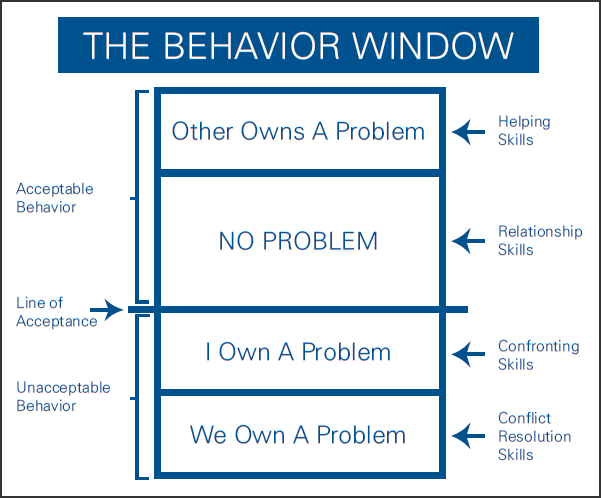Some of you may know about the Behavior Window from your L.E.T. or other Gordon Training workshop (P.E.T., Be Your Best, etc.). Or maybe it sounds or looks familiar, but you need a little refresher. Okay so…before we get to that, I just wanted to point out something:
You can learn all the skills in the world to help you have better relationships, but what drives you to want to use them is the key to their effectiveness. These people you work with every day? You need those connections to be strong, trusting, collaborative and respectful, right? That seems like a pretty strong motivation to do whatever you can to strengthen those relationships.
So keeping that in mind, let’s check out this Behavior Window or what I like to call your “Relationship GPS”.
This window was created by Dr. Thomas Gordon in the late 1960’s when he began offering his P.E.T. program–and it was his way of helping people place a behavior in an area so then they could figure out what skill would be most effective in addressing the issue, behavior, etc.
Okay, here comes the refresher!
- If the other person is signaling that they are upset or experiencing a problem or concern, place that signaling behavior in the top (first) part of the Window.
- If both you and the other person are functioning effectively, i.e., neither of you is bothered or upset, place that behavior (what you both are doing that is effective, etc.) in the second part of the Window.
- When the other person’s behavior is interfering with you, i.e. you are upset, worried, etc., because of something they are doing or saying, put that person’s behavior in the third part of the Window.
- When both of you are experiencing upset feelings, i.e. are in conflict with each other, place those behaviors in the fourth (bottom) part of the Window.
An important initial step in applying the Gordon Model is to answer the question: “Who owns the problem?” and then to choose and use the appropriate skill.
The four basic forms of problem ownership are:
1) Other Person Owns the Problem: Skills for helping the team member help himself/herself (Active Listening)
2) No Problem in the Relationship: Skills and concepts for enhancing the relationship (I-Messages, Active Listening)
3) I Own the Problem: Skills for clearing up situations where the team member’s behavior is a problem for the leader (I-Messages, Shifting Gears)
4) We Own the Problem: Skills for resolving conflicts so leader’s and team member’s needs are met (ALL of the Gordon Model skills)
And when you take L.E.T., you learn how, when, why and how to use all of these skills. And you’re on your way to better relationships!

